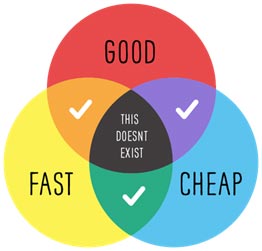I’m sure we’ve all been there. We have been asked to create some training. We’re on a deadline. The parties involved all seem to want or need different things.
Some of those asks might contradict one another or even be in direct conflict. Is there a way that we can make sure all parties are satisfied? Is it appropriate to meet everyone’s demands, or can the learning output suffer as a result of “people pleasing”?
In this blog, we will outline five top tips for managing expectations when we have many cooks in the kitchen.
1. Outline what the needs are.
It may sound simple, but it can be hard to keep a jumbled mess of different parties and requests in your head. Creating a table can help us step back and clearly see who is involved and what is being asked of us.
Legal/Regulatory Requirements
- You must cover these topics.
- You must refer to this law or regulation.
- You must deliver the training by this date.
- You must provide evidence that training has been delivered.
Stakeholder Requirements
- We want learners to pass a test.
- We want learners to sign a declaration.
- We want to track certain metrics or achieve certain measurable outcomes.
- We want certain people to be involved.
- The learning is expected to go out to specified audiences.
Learning and Development (L&D) Requirements
- The output must pass Quality Improvement (QI) inspection.
- The output must meet our or the client’s style guide and brand guidelines.
- We want to make something innovative and engaging.
- We want to achieve a satisfaction rating of X.
Learner Requirements
- Tell me what I need to know.
- Make it relevant to my role.
- Make it interesting.
- Respect my time and make it worth my while.
- Respect my intelligence.
This outlines what the needs are helps us get things out of our head and onto paper. It becomes tangible, something that we can see and review. It might suddenly seem less daunting or complex.
2. Consider where those needs are coming from.
Empathy is a key skill of any instructional designer. We talk about putting ourselves in the learner’s shoes. That makes sense; we want to deliver an impactful solution that they value and enjoy. We commonly see the learner as our end user, our primary customer.
That same viewpoint can sometimes cause us to see our stakeholders, legal teams, or I regulators as the bad guys. What they’re telling us to give the learner might seem boring, counterintuitive, or heavy handed. We need to remember that those people are also our customers. We need to put ourselves in their shoes, see things from their perspective, and consider where their proposed solutions are coming from.
“That’s interesting. Tell me how you came to that conclusion.” That is a very powerful and insightful approach. It can help us get on the same page as our key stakeholders and work together for the best learner outcomes.
3. Look for alignment.
It can be easy to see, and focus on, needs that seem to contradict each other. It might feel like the regulatory end of the spectrum is strict, information based, and inflexible, while the learner end is fun, experiential, and pioneering.
In many cases, those audiences are more compatible than we might assume. Yes, a legal team might say that we have to deliver a particular message, but how we deliver that message is up to us as instructional designers. We can translate technical wording into plain English. We can provide contextual scenarios. We can build in interactivity and even experience—all while still meeting those requirements.
4. Challenge appropriately.
There are times when we should suggest alternative approaches or politely decline requests. To stray from L&D for a moment, my son wants to eat pepperoni pizza every night. Now I know that isn’t a balanced diet, his nutrition would suffer, and he would eventually get bored of pizza. There’s a difference between what my son wants and what my son needs.
Let’s say that the quality or quantity of work that the stakeholder is requesting is unlikely to be achievable with the deadline they have given you. That’s a great time to seek a compromise.

Our first question might be, “Is there scope to move the deadline to accommodate your requests?” It’s important to understand if we are working with a hard or soft deadline. It’s ok to ask, “Why is this the deadline?” The reason may be compelling or vital to the lessons that need to be learned.
If we are working with a hard deadline, we need to make choices about the scope of work and deliverables. The classic good, fast, cheap model can be incredibly useful here.
It’s worth asking questions such as, “You have asked for a test. The regulator has asked that we provide evidence the learning has been delivered and received. Is a test necessary to meet the business’s and learners’ needs? What do we gain from it?”
Often, a blend of questioning, challenging, and empathy can result in a better experience and stronger outputs for all involved.
5. Be an ally.
When we see contradictory or incompatible asks from multiple parties, we might assume that we’re in for an argument. We can subconsciously prepare ourselves for conflict, which becomes a self-fulfilling prophecy. “If you go looking for a fight, you’ll find one.”
Showing people that you understand where their request is coming from and offering them alternative solutions shows them that you are not their enemy. We have shared goals and a shared stake in the project’s success. We are on the same team.
There will be times when the appropriate answer is no. You may be asked to track a learner’s individual clicks or how long they have spent on a page, while your authoring software, output format, or learning management system (LMS) does not support that level of reporting.
In these cases, how we say no is often more important than the fact that we’re saying no. Remain calm, rational, and explain the reasons. We never know, it might just lead to getting that upgraded software or LMS that we’ve been asking for!
In summary
Instructional designers can keep regulators, stakeholders, and learners happy by:
- Outlining what the needs are.
- Considering where those needs are coming from.
- Looking for alignment.
- Challenging appropriately.
- Being an ally.
We hope that you’ve found this useful. You can find more blogs on our website, https://www.pulselearning.com. If you have an upcoming L&D project, and you would like to partner with an industry leader with over 20 years’ experience, book a call with us today!


